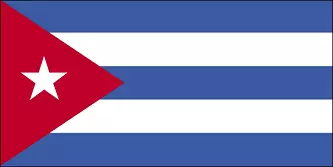With the arrival of the Europeans and other people, particularly those from Africa, the culture slowly changed. Through much of the island's modern history the cultural changes have been fairly similar to those of the greater Caribbean with African influences in the way of music, dance, and food, but the Spanish continued the cultural dominance in the forms of language, religion (Catholicism), clothing, foods, and lifestyle. However, with shipping lanes passing by the country and international trade, the culture also gained aspects from numerous other cultures and peoples.
Although the true core of the culture in Cuba is based the people who settled the island, it is the recent history, under communist rule, that is perhaps more visible today. The communists have discouraged religion, isolated the country from numerous foreign governments, and have even prevented their own people from traveling abroad. This isolation and strong governmental rule has created a culture that is developing on a fairly unique path as communist ideologies have changed the mindsets of the people and much of life and the economic is domestically-focused.
Due to this isolation in Cuba, technology and social progress arrived slowly, although in some social realms the country has progressed very rapidly as education and healthcare has vastly expanded. Today the country is attempting to imitate the world in some ways, but in many ways the people don't desire foreign influences. This isolation has maintained a traditional culture in many ways as it has kept a balance between people and nature that is rarely seen in the world today. However, this isolation has also dramatically changed the culture in many ways, such as through the destruction of religion.
Today the wildlife in Cuba and in the seas around Cuba still exist in substantial numbers and today the people can typically survive off the plant life and animals on or around the island. In this way the people continue to live a fairly simple life rooted in their past and the nature around them. Even in the present day the people live off the land more than most people do as fishing and farming are substantial industries. However, many other changes are underway as a stagnant economy has forced the government to open its doors as tourism is rapidly expanding and foreign influences are changing the people regularly. In what direction these internal and external forces will move the people and their culture is still uncertain.
 The three blue stripes on Cuba's flag represent the three old divisions: central, occidental, and oriental. The two white stripes symbolize the purity of independence, and the red triangle symbolizes liberty, equality, and fraternity, as well as the blood shed during the struggle for independence. The star lights the way to freedom and is called La Estrella Solitaria or "The Lone Star," which was adopted from Texas's flag.
The three blue stripes on Cuba's flag represent the three old divisions: central, occidental, and oriental. The two white stripes symbolize the purity of independence, and the red triangle symbolizes liberty, equality, and fraternity, as well as the blood shed during the struggle for independence. The star lights the way to freedom and is called La Estrella Solitaria or "The Lone Star," which was adopted from Texas's flag.
Name: Republic of Cuba
Independence: May 20, 1902, Triumph of the Revolution Day: January 1, 1959
Capital: Havana
Currency: Cuban Peso
Population: 11,061,886 (2013 estimate)
Ethnicity: European, mestizo, & others
Language: Spanish
Religion: Roman Catholic